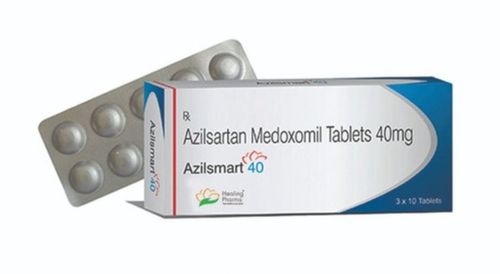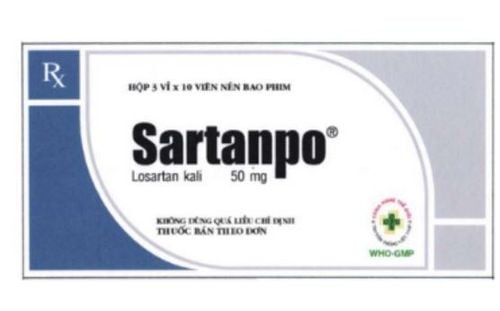This is an automatically translated article.
Hypertension is a common chronic disease worldwide. There are also many antihypertensive drugs available today. Including the active ingredient Losartan, with the trade name Zecard 50. So what does Zecard 50 do?
1. What does Zecard 50 do?
What does Zecard 50 do? The main ingredient of Zecard 50 is Losartan potassium, 50mg content. The drug is manufactured by Micro Labs., Ltd - INDIA, circulated in Vietnam with registration number VN-4053-07. Losartan is an active ingredient used to treat hypertension, which is an angiotensin II (AT1-type) angiotensin II receptor antagonist, and also reduces the risk of death from cardiovascular disease, stroke and myocardial infarction on hypertensive patients with left ventricular hypertrophy and renal protection for type 2 diabetic patients with proteinuria.
2. Indications - Contraindications of Zecard 50
Zecard 50 is indicated for the treatment of mild to moderate hypertension. Patients can use Zecard 50 alone or in combination with other antihypertensive drugs.
Zecard 50 is contraindicated for use in the following subjects:
Patients with hypersensitivity to the ingredients of Zecard 50; Pregnant; Women who are breastfeeding; Children < 18 years old.
3. Dosage - How to take Zecard 50
Initial and maintenance dose of Zecard 50: 25 - 50 mg, once a day. If necessary, the dose of Zecard 50 can be increased to 100 mg, once a day. Elderly (>75 years old), patients with renal impairment (moderate to severe) or patients with decreased endothelial fluid: start with 25 mg once daily. To reduce the risk of cardiovascular morbidity and mortality in hypertensive patients with left ventricular hypertrophy, a starting dose of 50 mg Losartan is usually given once daily with the addition of low-dose hydrochlorothiazide and/or increased dose. Losartan to 100mg once a day. Renal protection for patients with type 2 diabetes with proteinuria: Usually, the starting dose is 50mg Losartan, taken once daily, the dose of Losartan can be increased to 100m once a day. The maximum effect in the treatment of hypertension is usually achieved about 3 to 6 weeks after starting the drug. Increasing the dose up to 100 mg, taken once daily may be beneficial for some patients.
How to use: Zecard 50 is taken orally, patients can use Zecard 50 alone or with food. Zecard 50 can be combined with other antihypertensive drugs.
4. Drug interactions of the drug Zecard 50
Zecard 50 has the potential to interact with the following drugs:
Barbiturates, narcotic sleeping pills; Rifampin; Potassium-sparing diuretics; Potassium supplements, potassium salt substitutes; Non-steroidal anti-inflammatory drugs (NSAIDs); Alcohol; Corticosteroids ; ACTH; Muscle relaxants; Lithium; Quinidine. Anticoagulants; Gout Medicines; Anesthetic ; Glycosides; Vitamin D; Cholestyramine resin; Colestipol.
5. Side effects of Zecard 50
Zecard 50 has the potential to cause the following side effects:
Orthostatic hypotension, chest pain, grade II A-V block, sinus bradycardia, tachycardia, facial edema, flushing; Insomnia, dizziness, anxiety, confusion, depression, migraine, headache, sleep disturbance, fever, dizziness; Increased/decreased serum potassium, Gout; Diarrhea, indigestion, loss of appetite, constipation, vomiting, loss of taste, gastritis, intestinal spasms; Lower hemoglobin and hematocrit; Agranulocytosis, thrombocytopenia, aplastic anemia, hemolytic anemia; Back pain, leg pain, musculoskeletal pain, tremor, muscle weakness...; Hyperuricemia/hypouricemia (when using high dose Zecard 50), urinary tract infection, slight increase in creatinine/urea; Cough, nasal congestion, sinusitis, bronchitis, shortness of breath, nosebleeds, rhinitis; Alopecia, dermatitis, erythema, photosensitivity, pruritus, urticaria, bruising, rash; Impotence, decreased sex drive, polyuria, nocturia, renal failure, interstitial nephritis; Mild increase in liver function tests, increased bilirubin, hepatitis, cholestatic jaundice, pancreatitis; Blurred vision, conjunctivitis , impaired vision, burning and stinging eyes; Tinnitus, sweating; Hyperglycemia, hyperlipidemia (when using high dose Zecard 50); Hypomagnesaemia/Hypernatremia, Hypercalcemia, Hypochloremic alkalosis, Hypophosphataemia.
6. Be careful when using Zecard 50
Be careful when using Zecard 50 in the following cases:
Be careful when using Zecard 50 in patients with reduced intravascular volume, liver failure, renal artery stenosis. During pregnancy: Taking drugs that act directly on the renin-angiotensin system such as Zecard 50 during the second and third trimesters of pregnancy can cause low amniotic fluid, hypotension, and anuria. , oliguria, craniofacial deformity, and can even lead to infant death. Although the use of Zecard 50 only in the first 3 months of pregnancy has not been shown to be associated with a risk to the fetus, however, as soon as pregnancy is detected, the patient should stop losartan as soon as possible. Lactation: It is not known whether the losartan in Zecard 50 is excreted in human milk, however significant amounts of losartan and its active metabolite are present in the milk of rats. Therefore, because of the risk of harm to the nursing infant, a decision should be made whether to discontinue nursing or to discontinue Zecard 50 based on the importance of the antihypertensive drug to the mother. The active ingredient of Zecard 50 is Losartan potassium, which is indicated for use in the treatment of mild to moderate hypertension. Patients can use Zecard 50 alone or in combination with other antihypertensive drugs. To ensure the effectiveness of treatment and avoid unwanted side effects, patients need to strictly follow the instructions of the doctor, professional pharmacist.
Follow Vinmec International General Hospital website to get more health, nutrition and beauty information to protect the health of yourself and your loved ones in your family.
Please dial HOTLINE for more information or register for an appointment HERE. Download MyVinmec app to make appointments faster and to manage your bookings easily.













